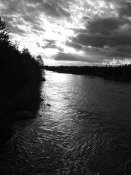under the big black sun: a fable
Congo street, so-named, north off 80 where the Trans-Southern railroad crosses. The old, willfully disremembered part of DeSiard, between downtown and the bypass. On either side of the tracks bumpy dirt right-of-ways follow the gentle curve out of sight; this is Congo street. Sad houses of 1920s union laborer vintage side by side, red-curtained, slack-porched, dimly seen as if still within that era's remnant light. Facing the tracks the way they might a highway or a river.
At night the mysterious pull in his gut as Mac pauses on the tracks. Where they veer away in the distance, shadowy, full of implication—poignant, if he possessed such a word. How far does it go? He's never quite actually driven the length, having made a few shy deliveries a couple hundred feet off DeSiard—something forbidden or shameful about a dirt street in the heart of town, belonging to another population entirely, an unfathomable group outraged by his appearance, his transgression. Congo. Mac wonders.
On the maps only small stretches are shown amenable to automobiles—the line broken by bridges or culverts or multi-lane thoroughfares. Yet the tracks on paper run unbroken all the way until the river. And further up on Washington he can gaze down from the opposite perspective of DeSiard's. It looks the same, yet different. Unallowable. Some space between here and there, untouched by official geography.
Mac knew all the streets. He had maps, hundreds of them, mostly repetitious copies, some even collectibles—though the concept would seem foreign to him. Had some local historian wanted them enough to make an offer, he would have happily given all away. But he read them, studied them, quizzed himself on the streets. Agony when one was forgotten, mis-sequenced; then came head-slapping, an unforgivable lapse. He's driven them all, known them all.
But Congo bothers him. His unease at navigating it. The incongruity of tracks running right up a street. The way the trees make it like some kind of tunnel.
Every street he drove connected with another street and all roads came together one way or the other, and he could drive circles on them forever.
A railroad goes on, straight on, and eventually ends. Must end.
Somewhere else.


